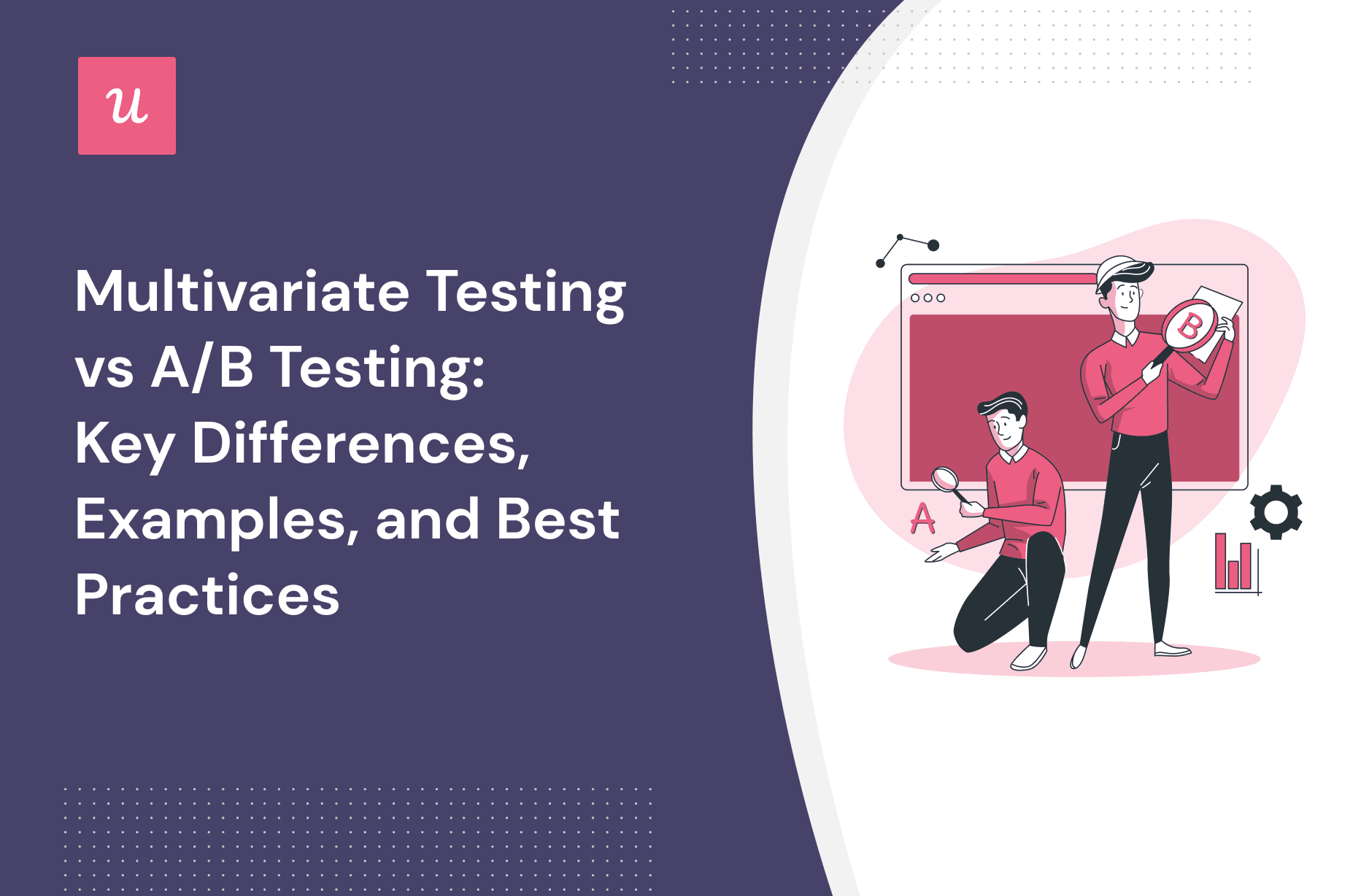
Multivariate Testing vs A/B Testing: Key Differences, Examples, and Best Practices
There’s a lot of confusion when it comes to multivariate testing vs A/B testing.
Are they the same? Is multivariate testing just A/B testing with more than two variants?
Well, not really. That’s why we’re going to clarify their key differences, as well as give you some advice to cultivate product growth with them.
Get The Insights!
The fastest way to learn about Product Growth, Management & Trends.
What is A/B testing?
In an A/B test, one variation change of a web page is compared against a control (the current version of the page) to see if it performs better. It allows you to make an evidence-based decision on what design elements, copy, or prompt are more effective for your conversion rates.
A/B testing isn’t exclusive to marketing, it also helps product managers test the usability of the product, understand user’s behavior, and drive users through their journey without friction.
What is multivariate testing?
Multivariate testing involves testing multiple variables at the same time (hence multi + variate), putting every possible combination against each other. It follows a factorial structure, which means that the total number of variations is the result of multiplying the number of iterations of each element.
For example, if you’re going to optimize a lead generation page with:
- 3 headlines
- 2 body copies
- 2 information forms
The number of combinations possible would be 3×2 ×2 = 12
This way, you can find out what combination of individual elements brings the ultimate best results.
Multivariate testing vs AB testing: 5 Key differences
There’s a chance you’ve heard someone say you should conduct a multivariate test when in reality they were just referring to an A/B/C test.
So let’s clarify the difference between both.
Testing methods
The primary difference is that multivariate tests iterate multiple elements (more than two) at the same time. While A/B testing tracks only one variant against the control.
And although A/B/C tests exist, the results usually don’t have the same weight as the multivariate factorial comparisons.
So, in scenarios where you need more data points, references, and proven ideas to improve a page or product, the multivariate method will provide better insights.
Implementation complexity
Although the multivariate method is sometimes seen as an A/B test with more variables—it’s far from being that simple.
Multivariate testing doesn’t only require more versions. This test must compare every single combination of elements that could significantly impact your results. And it doesn’t help that you need to ensure that the sample size for each version is big enough to be statistically valid.
Plus, it has different types including:
- Full factorial multivariate testing.
- Fractional factorial multivariate testing.
- Taguchi multivariate testing.
So, if you don’t have the expertise, the resources, and the tools to handle the multivariate method, then starting with A/B testing is probably the easiest way.
Comparison of end results
In A/B testing, you only look at which version converted more, and then take the winner.
With the multivariate method, you’re weighing the statistical significance of every single combination in order to find the best possible combination. Here, the winner is the version that achieved more of the desired goal, whether it is generating leads, sales, clicks, etc.
Thus, A/B testing could be the better way to go if you need to optimize fast and make more straightforward decisions.
Sample size
As for sample size, both methods require enough data to be statistically significant. However, A/B testing doesn’t need as much traffic (although the more traffic the better) since you’re only dividing your traffic in two.
The challenge is, the multivariate method compares way too many versions that it will spread your traffic too thin. Thus, you need to make sure that you’re bringing enough traffic so the sample size for each version is statistically significant (which is… a lot).
That said, A/B testing is most suitable for small businesses and startups that can’t afford to bring massive volumes of traffic for multiple variants.
Testing goals
Now, the major difference between both testing methods is their goal.
The A/B testing goal is to significantly improve the performance of a page by iterating one element at a time. Here, a variation is tested against the control (which is the unchanged page) continuously until you find a version that outperforms it and becomes the new control.
Whereas, the multivariate method’s purpose is to craft the best possible version of your page based on statistical evidence. It does it by massively testing multiple combinations of elements until there’s a proven winner.
Examples of use cases for A/B testing
Given their differences, the use cases for A/B and multivariate testing can be quite distinct depending on the context.
As for A/B testing examples, let’s go over some use cases that are relevant for product managers, including:
- Testing onboarding checklists for activation.
- Trying different in-app tooltips to optimize feature discovery.
- Test in-app experiences to improve product adoption.
Improve user activation by A/B testing onboarding checklists
The goal of an onboarding checklist is to see if it helps users reach the activation stage quicker—reducing time-to-value.
To A/B test it, all you need to do is to track an event that indicates activation (such as interacting with a core feature, inviting your team, etc), and measure if including the checklist represents a significant improvement.
For instance, Userpilot’s activation event is to build the first in-app flow. So once it’s set up as a trackable event, all you’d need to do to A/B test an onboarding checklist is to set the “first in-app flow” event as the goal:

Drive feature discovery by A/B testing tooltip implementation
Triggering in-app tooltips can be helpful to drive feature discovery—incentivizing users to engage with new or underused features.
But does it work for you? To know it, you can A/B test these tooltips by setting feature interactions as the goal.
For example, you can try showing a tooltip to half of a group against not showing the tooltip at all to the other half. Maybe most users will dismiss it because they find it annoying, or maybe they’ll find it useful because it allows them to solve a problem.
This test will determine if adding tooltips will drive more customer engagement. And to A/B test it, all you’d need to do is to set “click a feature” as your tooltip’s goal:

Implement A/B testing for in-app experiences to drive user adoption
Optimizing your product adoption can be a quite large task, as it involves many stages, tasks, and milestones to complete.
But, it is possible with A/B testing.
For example, you can implement in-app guidance across multiple customer journey touchpoints to improve adoption. This way, users are more likely to take the next best action to achieve success.
To optimize it, you can A/B test in-app experiences to see if it helps users more. An instance could be creating an interactive walkthrough to aid onboarding, and testing it with a control group to see if it leads to better user adoption.

Note: In this case, “achieving adoption” as a goal would mean tracking a custom event (a group of different events that indicate success such as inviting your team, activating all core features, etc). So, make sure to clearly define your user adoption events when testing an in-app experience.
Mobile surveys are a quick way to measure customer satisfaction, gather real-time feedback, and boost engagement.
Examples of use cases for multivariate testing
As for multivariate testing, it’s mostly used on marketing assets with massive sources of traffic. As those are the instances where it can get a big enough sample size.
So let’s go over a couple of examples, including:
- Trying various elements of a landing page to optimize conversion rates.
- A/B test multiple variables of an email campaign to optimize performance.
Test multiple elements to optimize landing page conversion rate
You could A/B test landing pages with different tests, headers, or designs. But the results won’t be as thorough or insightful given the sheer number of conversion-affecting elements in landing pages.
With multivariate testing, you can combine every single component of a landing page, including:
- Body copy
- CTA button
- Headers
- Image placement
- Color palette
- Scrolling depth
As a result—and given you gathered enough data—you’ll be able to craft a high-converting landing page with a scientific approach rather than doing random iterations.
Optimize email campaign performance by testing different variables
Email marketing is probably the most A/B-tested thing in the world.
But believe it or not, emails have a ton of subtle elements that affect both open rates and click-through rates. Including:
- Subject line.
- Opening line.
- Sender name.
- The day of the week you send it.
- The hour of the day you send it.
- The number of CTAs.
- The text format.
- Messaging.
- The P.S.
With all the possible combinations, multivariate testing is probably the most suitable way to optimize your email campaigns. You’ll be able to test every possible combination and create the ultimate email sequence for your business.
Compared to A/B testing, the multivariate tests will get you further away as long as your email list is big enough.
Best testing practices for multivariate testing and A/B testing
Regardless of your testing method, there are some best practices you should follow to get significant data out of your results, and they include:
- Have one clear goal. With a testing goal, you can decide what elements you should test and how many versions should be enough for your test. For example, if you were to track the CTR of an email, you can test elements such as titles, sending times, etc.
- Have a testing plan. Conducting many tests at the same time will lead to overlapping results (and confuse you even more). Instead, have a plan and perform one test at a time based on your priorities and what you think will be more significant.
- Test high-impact elements. Although multivariate testing helps you with multiple variables, avoid testing every single thing (or you’ll waste traffic on unnecessary versions). Brainstorming and validating ideas with research is key to coming up with high-performing versions, so make sure that you’re only testing elements that are proven to convert more.
Conclusion
As for the “multivariate testing vs A/B testing” discussion, they’re different faces of the same coin.
At the end of the day, you should always be on the lookout for areas of improvement within the product. So, come up with your hypotheses, conduct multiple tests, and make the most evidence-based decisions available.
Plus, if you’re a product manager who needs to run in-app A/B tests without code, book a demo call with our team and get our help!






